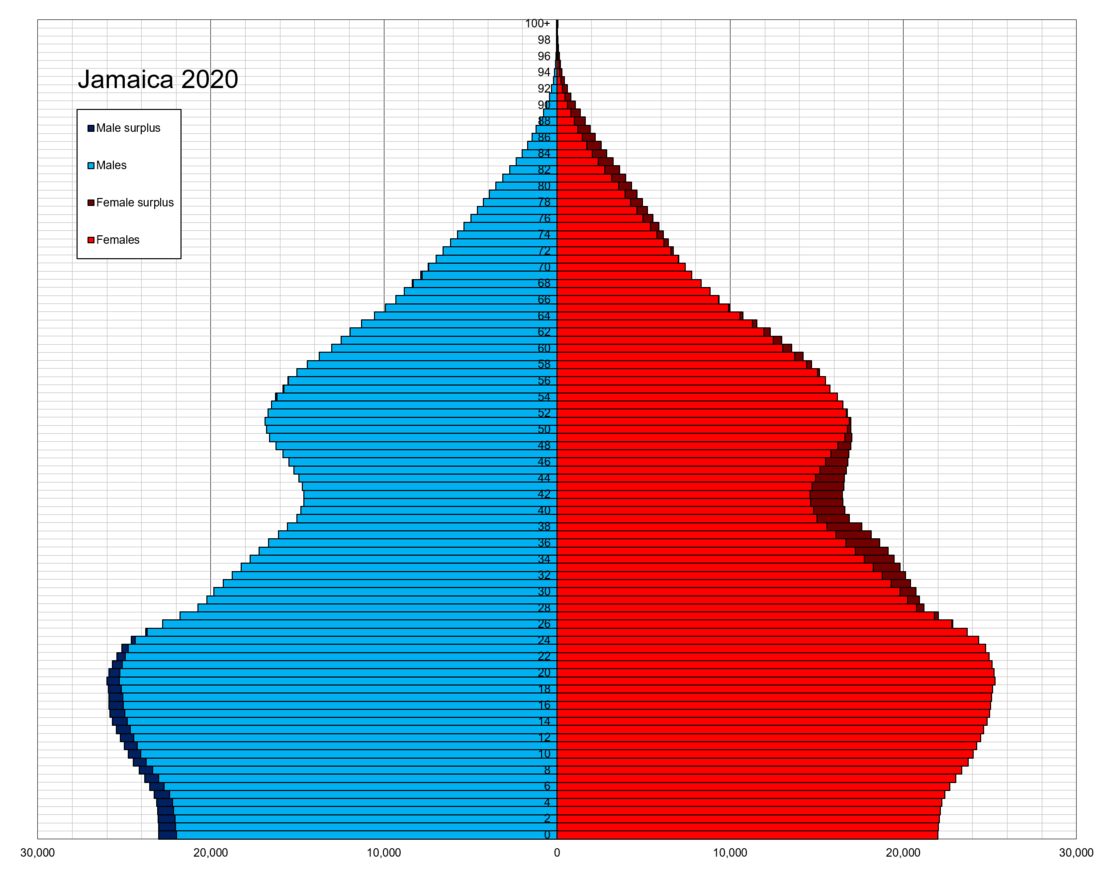Top Qs
Timeline
Chat
Perspective
Demographics of Jamaica
From Wikipedia, the free encyclopedia
Remove ads
Jamaica is an island country in the Caribbean. The country had a population of 2,825,352 as of 2023, having the fourth largest population in the region.
Jamaica's annual population growth rate stood at 0.08% in 2022. As of 2023, 68.9% of Jamaicans were Christians in 2011, predominantly Protestant.
The racial demographics in the island of Jamaica are as follows: 76.3% African, 15.1% Afro-European, 3.4% Indian or Afro-Indian, 3.2% White, 1.2% Chinese or Afro-Chinese and 0.8% Others (2024 est.).[1]
Wealth or economic power in Jamaica is disproportionately held by White Jamaicans, Chinese Jamaicans, Lebanese/Syrian Jamaicans, Indian Jamaicans and mixed-race Jamaicans (or locally called the Brown Man or Browning)— despite being minority groups (less than 25% of the country's population), they control most of the country's wealth.[3]
Roughly 10 per cent of the population, controls over 60% of Jamaica’s wealth.[4]
Remove ads
Population size and structure
Summarize
Perspective
According to the 2022 revision of the World Population Prospects[5][6] the total population was 2,827,695 in 2021, compared to only 1,403,000 in 1950. The proportion of children below the age of 15 in 2010 was 29%, 63.1% was between 15 and 65 years of age, while 7.8% was 65 years or older.[7]
Structure of the population
Population by sex and age group (Census 04.IV.2011): [9]
Population estimates by sex and age group (01.VII.2019): [9]
This graph was using the legacy Graph extension, which is no longer supported. It needs to be converted to the new Chart extension. |
This graph was using the legacy Graph extension, which is no longer supported. It needs to be converted to the new Chart extension. |
This graph was using the legacy Graph extension, which is no longer supported. It needs to be converted to the new Chart extension. |
Remove ads
Vital statistics
Summarize
Perspective
Registered births and deaths
Life expectancy at birth
Source: UN World Population Prospects[13]
Remove ads
Ethnic groups
Summarize
Perspective
76.3% African, 15.1% Afro-European, 3.4% Indian or Afro-Indian, 3.2% White, 1.2% Chinese or Afro-Chinese and 0.8% Others (2024 est.)[1]
Afro-European/Mulatto
The group in Jamaica—composed largely of mixed-race and lighter-skinned —has played a crucial role in shaping the country’s political and economic structures since the colonial era. Their shared experiences, social networks, and cultural practices have distinguished them from the Black majority in meaningful ways.
Origins and Colonial Foundations
During slavery, mixed-race Jamaicans—often the offspring of white plantation owners and enslaved Black women—were granted privileges that darker-skinned enslaved people did not receive. They were more likely to be educated, inherit property, and secure administrative positions within the colonial system. This created a distinct social identity, reinforced by their proximity to whiteness and European cultural norms.
After emancipation in 1838, the colonial government relied on this buffer class to manage administrative affairs and maintain order. They were groomed to uphold British cultural standards, including speaking "the Queen’s English" and rejecting Jamaican Patois, which was associated with the formerly enslaved population.[14]
Post-Independence Role
Following Jamaica’s independence in 1962, the buffer class transitioned into a modern technocratic elite. They occupied influential positions in government, business, and academia, often aligning with foreign economic interests rather than grassroots Black empowerment. This class was instrumental in shaping Jamaica’s political economy, ensuring that colonial-era structures of wealth and power remained largely intact.[15]
Cultural Distinctions
- Language and Speech Patterns:
Members of the buffer class were often educated in British-style institutions and spoke Standard English, distancing themselves from Jamaican Patois, which was associated with the working-class Black population. This linguistic divide reinforced social hierarchies.[16]
- Educational and Professional Networks:
Many attended elite schools such as Jamaica College, Wolmer’s, and Campion College, which historically catered to lighter-skinned Jamaicans. These institutions fostered tight-knit social circles, reinforcing their distinct status.[17]
- Marriage and Social Mixing:
The buffer class tended to intermarry within their own group, maintaining their lighter complexion and social advantages. This practice helped preserve their economic and political influence across generations.[18]
- Economic and Business Interests:
Historically, mixed-race elites dominated commerce, banking, and managerial positions, while the Black majority was largely confined to labor-intensive roles. Even today, remnants of this economic stratification persist.[19]
- Political and Ideological Leanings:
While some members of the buffer class supported progressive movements, many aligned with conservative or technocratic governance, favoring policies that maintained economic stability rather than radical redistribution.[20]
- Cultural Preferences and Eurocentrism:
The buffer class often embraced European fashion, music, and social etiquette, distinguishing themselves from Afro-Jamaican cultural expressions. This was evident in their participation in exclusive clubs and organizations.[21]
Historical Context and Persistence
The buffer class emerged as colonial intermediaries, managing plantations, businesses, and administrative roles. After independence, they transitioned into modern technocrats, maintaining their influence in government and industry. While racial barriers have softened, class divisions remain deeply entrenched.[22]
Comparative Perspectives
Similar patterns existed in Haiti, Brazil, and English Speaking Caribbean Islands, where lighter skin elites occupied privileged positions, reinforcing colonial hierarchies. In Jamaica, the persistence of this group highlights how race and class remain intertwined, shaping access to wealth and power.[23]
Historical
Remove ads
Languages
English, Jamaican Patois
Religion
Protestant 64.8% (includes Seventh Day Adventist 12.0%, Pentecostal 11.0%, Other Church of God 9.2%, New Testament Church of God 7.2%, Baptist 6.7%, Church of God in Jamaica 4.8%, Church of God of Prophecy 4.5%, Anglican 2.8%, United Church 2.1%, Methodist 1.6%, Revived 1.4%, Brethren 0.9%, and Moravian 0.7%), Roman Catholic 2.2%, Jehovah's Witness 1.9%, Rastafarian 1.1%, other 6.5%, none 21.3%, unspecified 2.3% (2011 est.)
Remove ads
See also
References
External links
Wikiwand - on
Seamless Wikipedia browsing. On steroids.
Remove ads

